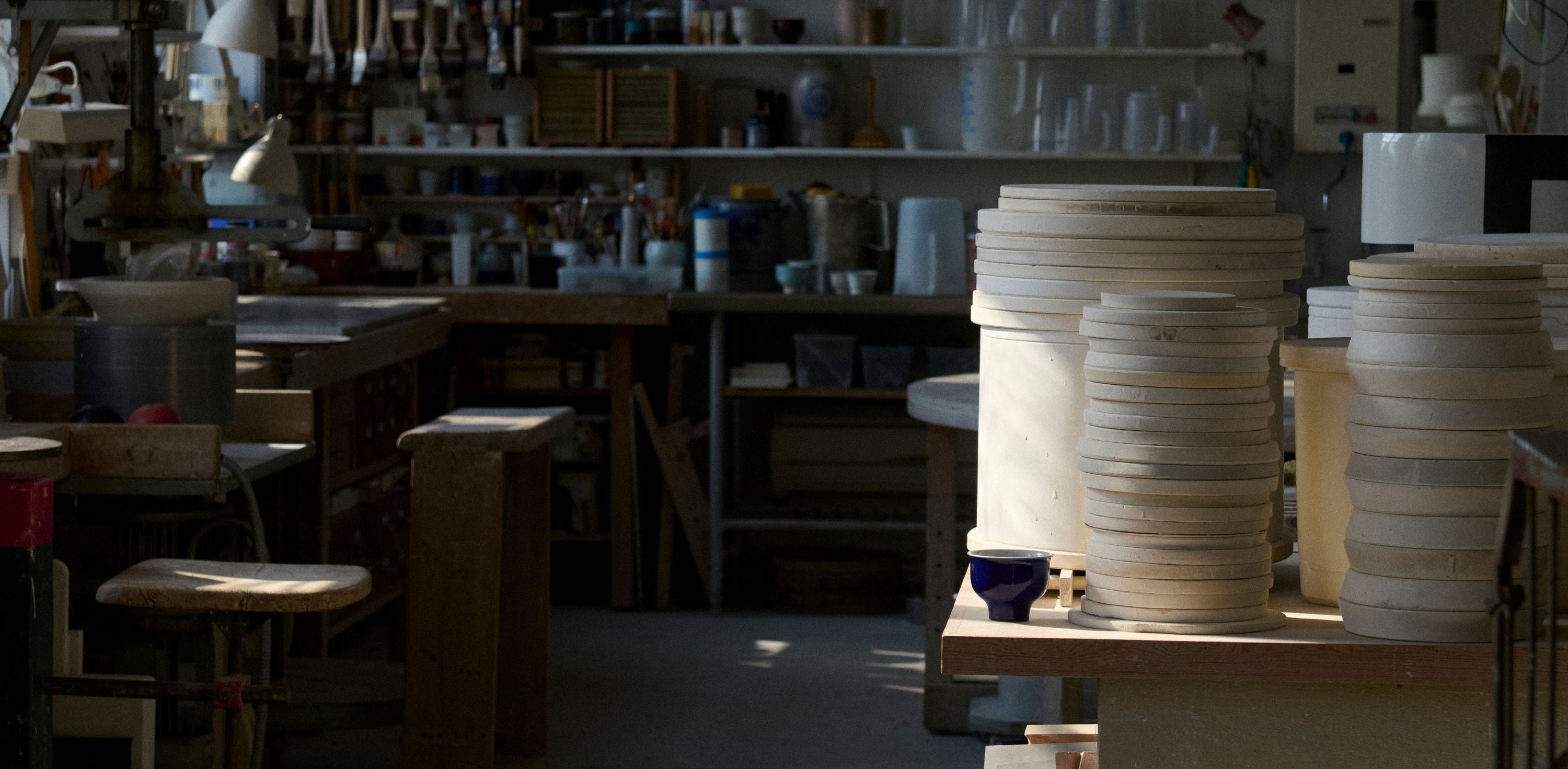1616 / arita japan presents 1616 / Manz Contour by Richard Manz – a collection distilling form down to its most elemental and humane qualities.
Renowned for his mastery of form and material, Danish ceramist Richard Manz (1933–1999) dedicated his career to exploring both everyday objects and distinctive sculptural work, imagining them with keen attention to geometry, proportion, and utility.
Each of his pieces was developed through rigorous experimentation, reflecting his laboratorial mindset and problem-solving nature. He believed there was a reason for everything in a design, and here lied on a process of scrupulous deduction and experiment before finalising a single object. His work embodies a quiet perfectionism, an obsessive refinement of shape, and a deep understanding that beauty and function are inherently intertwined.
1616 / arita japan is proud to introduce two new additions to its collection: the Tea Cup and Hojicha Cup, based on original designs by Richard Manz. These refined functional pieces have been carefully developed in collaboration with his daughter, the designer and frequent 1616 / arita collaborator Cecilie Manz, upholding the craftsmanship and precision that define our shared approach to porcelain.

The glaze corner in the workshop

Jigging machine in Bodil and Richard Manz’s workshop

Cast moulds
Born in Germany, Manz began his career at just 14 years old as a potter apprentice and oven tile maker. He later moved to Sweden, where he worked at Gustavsberg, discovering the potential of studio ceramics and small-scale production. This period marked the beginning of his lifelong exploration of form and function, leading to a body of work that balanced technical precision with the innate humanity of handcrafted ceramics.
In the 1970s, Richard Manz traveled to Japan alongside his wife Bodil Manz, also an esteemed ceramist, and their, at that time, two children. They settled in the village of Arita, the historic heart of Japanese porcelain production. Here, they worked at a porcelain factory, learning from centuries-old traditions while reflecting on their own Scandinavian perspective.
In many ways, the launch of the Tea Cup and Hojicha Cup represents a homecoming – a return to the place that deeply influenced Manz’s design philosophy. Upon returning from Japan, the couple continued work in their own workshop, where Manz refined his approach balancing an engineer-like attention to detail with artistic integrity. His technical skill and knowledge of industrial production found new purpose in a small studio practice, exploring function, geometries, and scale – defining his work until the very end.

Richard Manz, Watercolour, Japanese landscape, Arita 1975
The Hojicha Cup, also referred to as the ‘apple cup,’ was inspired by traditional Arita-ware and originally adorned with a single hand-painted apple by Bodil Manz. The cup’s slightly flared lip enhances the drinking experience, allowing liquid to flow smoothly, while its balanced proportions make it an ideal companion for tea, coffee, or other contemplative drinks. The cup’s form, rooted in both Danish and Japanese traditions, speaks to the endurance of Manz’s designs and his ability to distill a shape down to its most elemental qualities.
The Tea Cup is a form that Manz returned to repeatedly throughout his career, continuously refining its proportions. The stackable design reflects the freedom that comes with studio practice – the ability to play with and evolve a shape over time. The small foot at its base allows it to sit particularly well in the hand, creating a natural balance that enhances the drinking experience – an intuitively appealing object.
“These cups are a link between past and present, between tradition and everyday life,” says Cecilie Manz. “My father’s approach was always one of refinement – looking at an object over and over again, removing what was unnecessary, and making sure that what remained was exactly right. I believe these pieces reflect that sensibility, and I am grateful to 1616 / arita for giving them new life.”

MANZ Tea Cup, Blue in the workshop
Crafted in Arita, Japan’s historic porcelain capital, these designs reflect a synthesis of Scandinavian restraint and Japanese precision. The collaborative nature of this project, developed in close dialogue with Richard Manz’s family, highlights the long-standing dialogue between Japanese and Danish design traditions, both of which value simplicity, function, and an appreciation of materials in their purest form. Both cups are produced in partly unglazed and fully glazed versions, offering a choice between a more tactile feel and a smooth, refined surface. The unglazed exterior emphasises the natural texture of porcelain, making each sip an even more sensory experience, while the glazed options – in genuine Celadon, Clear, Blue and Brown, provide a classic, lucent finish.
Their neutral tones, carefully selected to respect the natural beauty of porcelain, ensure they complement any setting, from the minimalist to the eclectic.
A great effort has been made by the workshop to develop a porcelain that looks as true as possible to the original clay made by Richard Manz himself in his studio.
-
MANZ Tea Cup, Natural

 395,00 kr
395,00 kr -
MANZ Tea Cup, Brown

 395,00 kr
395,00 kr -
MANZ Tea Cup, Blue

 395,00 kr
395,00 kr -
MANZ Hojicha Cup, Natural

 375,00 kr
375,00 kr -
MANZ Hojicha Cup, Celadon

 375,00 kr
375,00 kr















